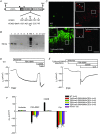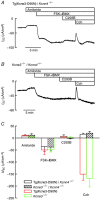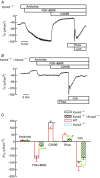K2P TASK-2 and KCNQ1-KCNE3 K+ channels are major players contributing to intestinal anion and fluid secretion
- PMID: 29143340
- PMCID: PMC5792569
- DOI: 10.1113/JP275178
K2P TASK-2 and KCNQ1-KCNE3 K+ channels are major players contributing to intestinal anion and fluid secretion
Abstract
Key points: K+ channels are important in intestinal epithelium as they ensure the ionic homeostasis and electrical potential of epithelial cells during anion and fluid secretion. Intestinal epithelium cAMP-activated anion secretion depends on the activity of the (also cAMP dependent) KCNQ1-KCNE3 K+ channel, but the secretory process survives after genetic inactivation of the K+ channel in the mouse. Here we use double mutant mice to investigate which alternative K+ channels come into action to compensate for the absence of KCNQ1-KCNE3 K+ channels. Our data establish that whilst Ca2+ -activated KCa 3.1 channels are not involved, K2P two-pore domain TASK-2 K+ channels are major players providing an alternative conductance to sustain the intestinal secretory process. Work with double mutant mice lacking both TASK-2 and KCNQ1-KCNE3 channels nevertheless points to yet-unidentified K+ channels that contribute to the robustness of the cAMP-activated anion secretion process.
Abstract: Anion and fluid secretion across the intestinal epithelium, a process altered in cystic fibrosis and secretory diarrhoea, is mediated by cAMP-activated CFTR Cl- channels and requires the simultaneous activity of basolateral K+ channels to maintain cellular ionic homeostasis and membrane potential. This function is fulfilled by the cAMP-activated K+ channel formed by the association of pore-forming KCNQ1 with its obligatory KCNE3 β-subunit. Studies using mice show sizeable cAMP-activated intestinal anion secretion in the absence of either KCNQ1 or KCNE3 suggesting that an alternative K+ conductance must compensate for the loss of KCNQ1-KCNE3 activity. We used double mutant mouse and pharmacological approaches to identify such a conductance. Ca2+ -dependent anion secretion can also be supported by Ca2+ -dependent KCa 3.1 channels after independent CFTR activation, but cAMP-dependent anion secretion is not further decreased in the combined absence of KCa 3.1 and KCNQ1-KCNE3 K+ channel activity. We show that the K2P K+ channel TASK-2 is expressed in the epithelium of the small and large intestine. Tetrapentylammonium, a TASK-2 inhibitor, abolishes anion secretory current remaining in the absence of KCNQ1-KCNE3 activity. A double mutant mouse lacking both KCNQ1-KCNE3 and TASK-2 showed a much reduced cAMP-mediated anion secretion compared to that observed in the single KCNQ1-KCNE3 deficient mouse. We conclude that KCNQ1-KCNE3 and TASK-2 play major roles in the intestinal anion and fluid secretory phenotype. The persistence of an, admittedly reduced, secretory activity in the absence of these two conductances suggests that further additional K+ channel(s) as yet unidentified contribute to the robustness of the intestinal anion secretory process.
Keywords: K+ channel; epithelial transport; fluid secretion.
© 2017 The Authors. The Journal of Physiology © 2017 The Physiological Society.
Figures






Comment in
-
Taking intestinal anion secretion to TASK: a role for K2P channels in cyclic AMP-regulated anion secretion.J Physiol. 2018 Feb 1;596(3):359-360. doi: 10.1113/JP275567. Epub 2017 Dec 27. J Physiol. 2018. PMID: 29205365 Free PMC article. No abstract available.
-
Enterocyte K+ ion permeability and fluid secretion: missing the correct channel or missing the point?J Physiol. 2018 Jun;596(12):2463-2464. doi: 10.1113/JP276102. Epub 2018 Apr 25. J Physiol. 2018. PMID: 29604065 Free PMC article. No abstract available.
-
Reply from L. P. Cid, T. J. Jentsch and F. V. Sepúlveda: intestinal electrolyte and fluid secretion - a model in trouble?J Physiol. 2018 Jun;596(12):2465-2466. doi: 10.1113/JP276139. Epub 2018 Apr 16. J Physiol. 2018. PMID: 29663391 Free PMC article. No abstract available.
Similar articles
-
Abolition of Ca2+-mediated intestinal anion secretion and increased stool dehydration in mice lacking the intermediate conductance Ca2+-dependent K+ channel Kcnn4.J Physiol. 2007 Sep 1;583(Pt 2):705-17. doi: 10.1113/jphysiol.2007.134387. Epub 2007 Jun 21. J Physiol. 2007. PMID: 17584847 Free PMC article.
-
Sexual dimorphism and oestrogen regulation of KCNE3 expression modulates the functional properties of KCNQ1 K⁺ channels.J Physiol. 2011 Nov 1;589(Pt 21):5091-107. doi: 10.1113/jphysiol.2011.215772. Epub 2011 Sep 12. J Physiol. 2011. PMID: 21911611 Free PMC article.
-
The small conductance K+ channel, KCNQ1: expression, function, and subunit composition in murine trachea.J Biol Chem. 2001 Nov 9;276(45):42268-75. doi: 10.1074/jbc.M105014200. Epub 2001 Aug 29. J Biol Chem. 2001. PMID: 11527966
-
The very small-conductance K+ channel KvLQT1 and epithelial function.Pflugers Arch. 2000 Jun;440(2):202-6. doi: 10.1007/s004240000257. Pflugers Arch. 2000. PMID: 10898519 Review.
-
KCNE1 and KCNE3: The yin and yang of voltage-gated K(+) channel regulation.Gene. 2016 Jan 15;576(1 Pt 1):1-13. doi: 10.1016/j.gene.2015.09.059. Epub 2015 Sep 26. Gene. 2016. PMID: 26410412 Free PMC article. Review.
Cited by
-
Structural basis for pH gating of the two-pore domain K+ channel TASK2.Nature. 2020 Oct;586(7829):457-462. doi: 10.1038/s41586-020-2770-2. Epub 2020 Sep 30. Nature. 2020. PMID: 32999458 Free PMC article.
-
Reply from L. P. Cid, T. J. Jentsch and F. V. Sepúlveda: intestinal electrolyte and fluid secretion - a model in trouble?J Physiol. 2018 Jun;596(12):2465-2466. doi: 10.1113/JP276139. Epub 2018 Apr 16. J Physiol. 2018. PMID: 29663391 Free PMC article. No abstract available.
-
Mechanisms of KCNQ1 gating modulation by KCNE1/3 for cell-specific function.Cell Res. 2025 Jul 31. doi: 10.1038/s41422-025-01152-1. Online ahead of print. Cell Res. 2025. PMID: 40745202
-
Tissue Distribution of Kir7.1 Inwardly Rectifying K+ Channel Probed in a Knock-in Mouse Expressing a Haemagglutinin-Tagged Protein.Front Physiol. 2018 Apr 23;9:428. doi: 10.3389/fphys.2018.00428. eCollection 2018. Front Physiol. 2018. PMID: 29740340 Free PMC article.
-
Structure and physiological function of the human KCNQ1 channel voltage sensor intermediate state.Elife. 2020 Feb 25;9:e53901. doi: 10.7554/eLife.53901. Elife. 2020. PMID: 32096762 Free PMC article.
References
-
- Abbott GW & Goldstein SA (2002). Disease‐associated mutations in KCNE potassium channel subunits (MiRPs) reveal promiscuous disruption of multiple currents and conservation of mechanism. FASEB J 16, 390–400. - PubMed
-
- Al‐Hazza A, Linley JE, Aziz Q, Maclennan KA, Hunter M & Sandle GI (2012). Potential role of reduced basolateral potassium (IKCa3.1) channel expression in the pathogenesis of diarrhoea in ulcerative colitis. J Pathol 226, 463–470. - PubMed
Publication types
MeSH terms
Substances
LinkOut - more resources
Full Text Sources
Other Literature Sources
Molecular Biology Databases
Miscellaneous

